Application Tips
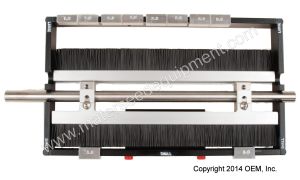
New Brush and Paddle Assembly Setting Fixture.
Quickly, easily, and precisely set the clearance between the drum and the brush or paddle assembly for your Mater Batch or Continuous Debearder.
- Set the support block up for your size drum and brush or paddle assembly with two thumb screws.
- Loosen the adjustment Screws in the slots of the brush or paddle assembly so that the brush or paddle can slide in and out.
- Slide the brush or paddle all the way in towards the shaft.
- Lay the brush or paddle assembly in the fixture using the slots nearest the support plate as shown above.
- Select and insert the pair of setting spacers for the drum clearance that you want.
- Place them on the fixture rail roughly inline with each of the adjustment screws.
- Lightly push the brush or paddle against the setting spacers and snug up the adjustment screws.
- Flip the brush or paddle assembly over and set the other side the same way.
- Done!
Debearding Onion Umbels to Clean Seed: Turning dried onion umbels into clean onion seed is excellent application for the Mater Batch Debearder. Select a Perforated Drum that will pass your clean seed – typically 4 mm diameter perforations. Choose the Fine Bristle Brushes with the Brush Holder Assembly to start.
Small Batches Secure the end plate and with the Brush Assembly turning, insert the whole umbels into the inlet of the debearder The seeds and most inert material will pass through the perforations in the drum and fall into the specimen tray. The stem (peduncle) and larger debris stays inside the drum to be removed before the next batch.
Hand Fed Continuous Operation Another method is to pull the stem out of the umbel first, then feed the head portion into the inlet. That way the debearder processes all the plant material and there are no stems to be removed from the drum.
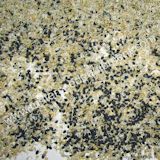 Click on thumbnail for larger image.
Click on thumbnail for larger image.
Seeds collected in the specimen tray will be stripped of their “caps”. Screen or blow the seeds to remove the inert plant material and you now have clean seeds.
Screening and Blowing after Debearding: Try screening or blowing to remove inert material and damaged seed from your debearded seed.
Screening If you have an assortment of screens (testing sieves) covering a wide range of mesh sizes, give screening a try. Even better if you have a sieve shaker to mechanize the process. Keep in mind that a stack of screens is a batch processing technique. It takes the right combination of screen meshes to effectively remove the inert material and finding the right combination takes time.
Blowing If your lots are small, as with purity analysis, an adjustable velocity batch blower will do the job. If you have more than a few grams of seed, a blower like the Mater Continuous Blower with digital speed control settings is the right tool for the job. The velocity is infinitely variable up to 18 m/s and suitable for all but the largest seeds.
Screening before Debearding: To facilitate debearding, consider screening your sample first. Remove all inert material larger and smaller than the seeds you plan to debeard.
To not make the inert material smaller and more difficult to separate out later, screen before debearding to remove the inert material. If your sample contains lots of inert fines, screen them out first.
If your sample contains large inert pieces (e.g. stems, empty seed pods), screen your sample to remove that inert material or, for small lots, pick out the large inert pieces by hand.
Removing appendages from Marigold and other flower seeds with the Mater Batch Debearder:To remove the “tail” from the seeds as shown in the image below, process them in a perforated drum wrapped with a rubber sheet. The pocket formed by rubber wrapper prevent the seed from passing out of the drum and shears off the “tail”. The processed Marigold seeds will now flow through a seed counter for packaging.
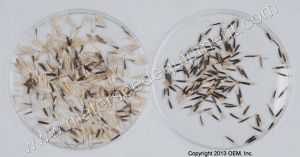 Click on thumbnail for larger image.
Click on thumbnail for larger image.
Method for Debearder Marigold seeds:
- Wrap the outside of a 3mm perforated drum with a rubber sheet.
- Adjust the brush holders for 2mm clearance from brush tips to drum.
- Place the rubber wrapped drum inside the debearder.
- Slip fine bristle brushes into the brush holder assembly.
- Install the brush holder assembly inside the machine.
- Run a batch of 300 to 500 cc at 200 rpm starting with 2 minutes and adjusting as needed.
- After run blow or screen the results to remove the fines.
Removing Appendages from Maple tree seeds with the Mater Batch Debearder:To remove the “wing” from the seeds shown in the images below, process them in a drum with 3mm perforations. As the paddle with ruber wipers rotates, it breaks up the tails”, pushes the “tail” ends into the perforations and shears off the remainder of the “tail”. The debearded seeds remain inside the drum and the inert passes thru the drum. The maple seeds are now ready to flow freely in a seed counter or automated planting machine.
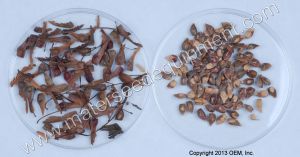 Click on thumbnail for larger image.
Click on thumbnail for larger image.
Method for Debearder Maple tree seeds:
- Use a 3mm perforated drum and the Paddle Assembly with Wipers.
- Adjust the paddle wiper assy for 3mm clearance from wiper edge to drum.
- Place the perforated drum inside the debearder.
- Install the paddle wiper assy inside the machine.
- Run a batch of 300 to 500 cc at 100 rpm starting with 2 minutes and adjusting as needed.
- After run blow or screen the results to remove the fines.
Barley, Wheat and Crimson Clover Seed Conditioning
Easier to setup than a gravity table, the wide velocity range of the Mater Continuous Blower is effective on seeds large and small. It is the ideal tool for seed breeders and low volume, high value seed producers to select the most viable seeds from any seed lot.
The image illustrates the result of blowing wheat in the Mater Continuous Blower. On the left side are the denser and presumably more vital seeds. On the right are the immature seeds and blanks.
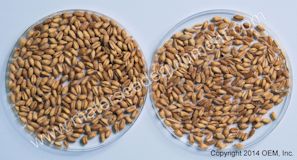 Click on thumbnail for larger image.
Click on thumbnail for larger image.
The doctoral thesis referenced below presents seed conditioning research results obtained with the Mater Continuous Blower. Although the emphasis was on field crop seeds, blowing is applicable to most types of seeds.
Thesis in Portuguese with English abstracts.
USE OF CONTINUOUS FLOWING BLOWER WITH VERTICAL AIR STREAM IN BARLEY, WHEAT AND CRIMSON CLOVER SEEDS
Author: Suemar Alexandre Gonçalves Avelar
Chapters:
1. Air Velocity Profile In A Continuous Flowing Blower With Vertical Air Stream
2. Barley Seed Conditioning
3. Crimson Clover Seed Quality Upgrading
4. Wheat Seed Conditioning
Blowing Soybeans for Crop Improvement Check out the picture below and see what you can do with the Mater Continuous Blower. The heavy fraction on the left is clean, whole soybeans and only a very few with damaged seed coats. The light fraction on the right contains mostly split or underdeveloped soybeans along with some inert.

